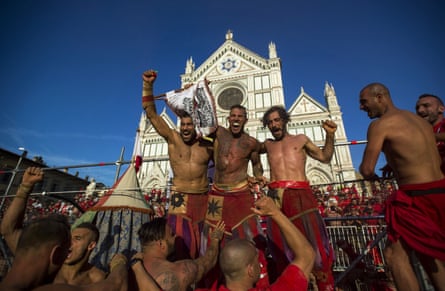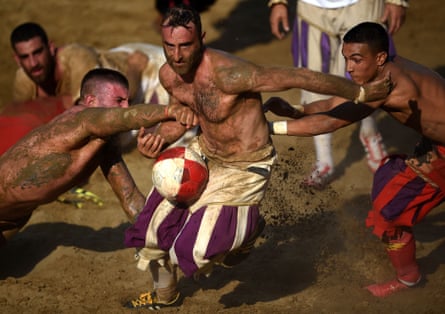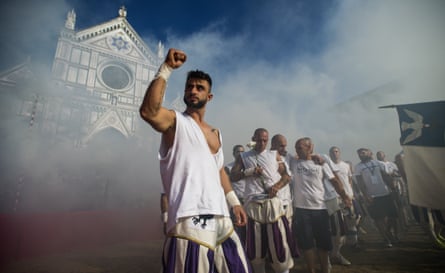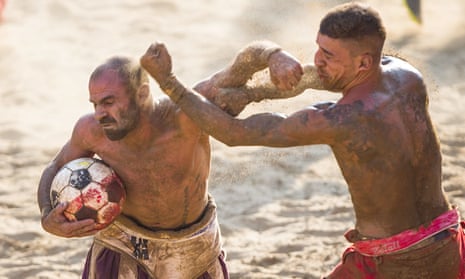Bruised, bloodied and battered, the 27 Bianchi players from Florence’s Santo Spirito neighbourhood celebrated winning the annual Calcio Storico Fiorentino Championship on Saturday night in the traditional way: by devouring as much Bistecca alla Fiorentina (a famous local steak) as they could eat. They had earned it.
They had been fortunate to make it to the final – they had been losing their semi-final 3-0 when one of their opponents from the Santa Croce quarter kicked a referee and had his team disqualified – but the final was a more taxing affair. After 50 long minutes of action, they secured a narrow 6-5½ victory over the reds of Santa Maria Novella to win their third consecutive title.
The aim of the game is fairly simple: players take to the Santa Croce square, which is about the size of a football pitch, and try to score more goals than their opponents by using any means necessary. Sucker punches and kicks to the head are forbidden but headbutting, punching, tripping, wrestling and choking are fair game.
The forwards try to pin down their opposite numbers so their team-mates can attack with the ball and head for goal. It is a brutal spectacle and even some locals cannot stomach the violence – the game’s popularity suffered in 1977 when a player had an ear bitten off – but it is undergoing a renaissance, especially among young people and tourists.

The rules were formally established in 1580 by Giovanni de’Bardi, who stipulated that players must be “gentlemen from 18 years of age to 45, beautiful and vigorous, of gallant bearing and of good report.” Most of the traditions remain and the final is always played on June 24, the feast day of San Giovanni, the city’s patron saint, but some of the rules have been tweaked over the years. Players over 40 and those with serious criminal convictions were banned in 2008, and another change will be introduced next year to prevent teams from fielding two non-Florentines.
This will mean that James Zikic, an MMA fighter from London who has been on the winning Bianchi side for the past three years, will have to miss out. Two Bianchi players – or calciantes – who will be hoping to make it four in a row are Giacomo Peggion and Lorenzo Taddeucci. Clasico storico players can be reluctant to speak to outsiders but they joined me for a chat after their victory on Saturday.
Giacomo, what does this mean to Florence?
“First of all, it’s a game, not a sport. It means a lot for the city, it adds to it specialness and uniqueness and makes Florence even more desirable. Winning the game will mean the end of a tough journey that started right after last year’s tournament. It will mean glory and happiness for the winning team. We choose to play this game for the same reasons a man climbs the highest mountains and sails the most tempestuous seas. Mankind wants to challenge and test itself and everybody does it in the way he prefers and the way that feels more natural to him.
What is more important to the players, the historical aspect or the game itself?
Both of the parts are fundamental. I love my city and playing Calcio Storico is a way to be even more in harmony with it. It’s like if you would meet the woman you love carrying some heavy items. You would carry those heavy things just to feel closer to her, more in contact. So I keep the Florentine traditions alive to feel even more part of the city. I want to help her to last a long time. I love the extreme nature of the game but don’t know if I would play if there wasn’t the traditional and historical component. There are a lot of extreme sports around. This is not a sport and it’s unique.

Lorenzo, how did you get into Calcio Storico?
I started in 2013 but my first year was just training. I was not good enough to play. I had to wait one year, then I made my debut in 2014. I have played the last three years and the Bianchi has won every game.
Why did you opt for the Bianchi in particular?
I chose Bianchi Santo Spirito because it’s my neighbourhood. It’s a natural choice. When you grow up there with your friends, you want to play for the local team with them. Bianchi are like Ferrari in Formula One; everyone wants to drive one. It’s the same with Calcio Storico, everyone wants to play for the white team.
Many Florentine families who had lived in the centre of the city have been priced out as property prices have soared. Does this make playing for the Bianchi more desirable to the locals?
The Santo Spirito area is the last real Florentine neighbourhood, so there is more connection with the team. A lot of my team-mates live and work in the neighbourhood so it gives us the “extra factor”. The white team is one of the best ever and it’s all of these things together that makes people want to play for them – but there are only 27 players so if you want to play you have to be in shape. I’m lucky to play for the Bianchi, we are like a family so it’s a natural thing for me.
What makes this game so special for the city?
It’s about pride. It’s about glory. You play for your city first of all, every time you step into the arena, it’s for the pride and the glory of your city. There is no money involved, so it’s just for honour and pride. Everyone recognises that, so that’s why this kind of game is so special for the Florentine people.
The incredible atmosphere inside the arena is attracting increasing number of foreign spectators every year. What is it like for those inside it?
Yeah, I can’t really begin to describe it, it’s something amazing. Everyone has their own feelings, it depends on the person, but for me it’s the best feeling ever – truly. You cannot have these kind of emotions in normal life. It’s once a year, twice if you are lucky enough to play in the final and you cannot describe it, trust me. You are like a gladiator or something like that.

Punching, elbowing, choking and headbutting are all allowed, prompting even some Florentines to say that it is too brutal. What do say to those who oppose it?
Violence? It’s part of the game. It’s a war game so of course you have to use violence if you want to win. Sometimes I don’t understand the critics. They say there is too much violence but they have missed the point. If you want to win that’s just what you have to do; it is what it is. I take the good with the good and the bad with the bad.
What does winning the finals mean to the team?
It’s a dream come true to win. You work so hard throughout the year and you share blood, sweat and tears with your friends. Hard work always pays off. When you work like this you can achieve your goals, so it is absolutely fantastic to win. Calcio Storico is an event for the city, so there can be no game without the historical part. It’s two sides of the same coin. It’s very beautiful, I love it.
Beautiful, bloody or barbaric, it is up to each person to decide whether they agree with what goes on inside Piazza Santa Croce every June. But for those who take the risk of being hurt, the brutality is part of what makes them feel at one with their city. Who are we to stop them?

Comments (…)
Sign in or create your Guardian account to join the discussion